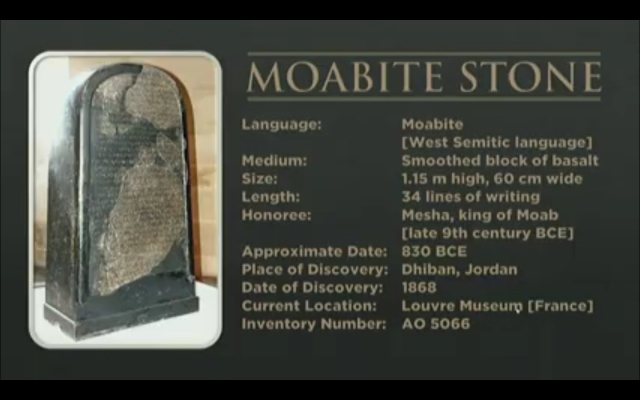After over a century, researchers have verified with a considerable degree of certainty that the “Mesha Stele”, an engraved stone slab discovered in 1868 east of the Dead Sea in modern-day Jordan, in fact, does contain explicit references to King David and events that correspond to biblical writings. Also known as the Moabite Stone, the Stele has provided historians and linguists with the greatest source of the Moabite language to date, a Canaanite dialect, once spoken in the region described in the Bible as Moab in the early first millennium BC.
The stele is currently in the Louvre Museum in Paris. Although damaged in 1869, a paper-mâché identical version of the inscription had been made before the damage occurred, allowing researchers to inspect the texts further. The stone seems to be some sort of declaration by King Mesha of Moab before he sent his people to war with King David’s Jewish Israelites. It describes events related in a similar account to the war that took place between The King David lineage kingdom of Israel and Moab within the book of Kings 2.
Facts. Huh. There’s a replica of the Meshe Stele in Trinity College that references the “House of David” and their god Yahweh, precursors to Judaism. Josephus and Tacitus both write about Jesus. None of them talk about Palestinians.
— 𝑻𝒆𝒓𝒆𝒔𝒂 🇧🇲🇮🇪🇮🇱🌻 #JusticeForMalkiRoth (@etc_tess) June 18, 2021
According to the bible “ Mesha King of Moab raised sheep, and he had to pay the king of Israel a tribute of a hundred thousand lambs and the wool of a hundred thousand rams. But after the Israelite King, Ahab died, the king of Moab rebelled against Israel. So at that time King Jehoram of Judah set out from Samaria and mobilized all Israel.”
Scholars were until now not entirely sure that these references to King David on the slab were correctly deciphered. In an article titled “Mesha's Stele and the House of David” published in the Biblical Archeology Review in late 2022, researchers André Lemaire and Jean-Philippe Delorme revisited the evidence, explaining how digital photographs and infrared scans of the "restored stele and skeleton in the paper" that were taken in 2015 helped fully decode the text.
The Moabite Stone contains a Canaanite inscription that proves the accuracy of an event in the Biblehttps://t.co/li9H3S4og1
— Larry Fearing (@FearingLarry) December 18, 2022
“The team used a method called Reflectance Transformation Imaging. This method is precious because digital rendering allows researchers to control the lighting of an inscribed artifact so that hidden, weak, or worn incisions become visible,” they said in the article. Thus, the researchers were able to get a much more precise idea of what was inscribed on the stele, leading to yet another discovery that further connects archaeological finds to the narrative told within the bible and validated it through historical fact.
The mention of King David led to another breakthrough in understanding the ancient people of the region. In the Stele, the words 'BT DWD' are written with reference to the Kingdom of Israel. In Hebrew the 'House of David' is written 'Bet Dawid (David)', in addition, there were marked similarities throughout the Stele written in the Moabite language and ancient Hebrew. The similarities of the two languages lead researchers to the conclusion that it is most likely that Hebrews and Moabites were able to understand one another given the similarities of the languages.
The Stele also refers to the Hebrew God and his might. References to a 'powerful' deity called 'YHWH', often called the 'Tetragrammaton', the letters often used in Hebrew as the name of the one God, are scattered throughout the stone. In order to defeat the Hebrews, appeasement of 'YHWH' would be necessary. Prior to the Mesha Stele's translation, the oldest written reference was on two pottery shards found in an area in northern Sinai known as Kuntillet Ajrud.
Yahweh, name for the God of the Israelites, representing the biblical pronunciation of “YHWH,” the Hebrew name revealed to Moses in the book of Exodus. The name YHWH, consisting of the sequence of consonants Yod, Heh, Waw, and Heh, is known as the tetragrammaton. pic.twitter.com/gDnlkIYpyW
— Doug OConnell (@DougOConnell7) January 9, 2023
t was once thought that the Phoenicians developed the first written language, however, archaeologist Douglas Petrovich of Wilfrid Laurier University in Waterloo, Canada recently discovered that ancient Egyptian stones carved over 3,800 years ago show that an early form of Hebrew sought to translate Egyptian Hieroglyphics. The find shows that the written Hebrew language likely predated the Phoenician period by several hundred years.


